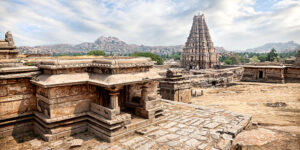One of the foundations of Indian Civilization (also called Indic or Bharatiya – to use a Sanskrit word) is the conception of the human potential for spiritual and transcendental realization. The primacy accorded this tendency towards the spiritual and transcendental, as well as the great plurality of perceptions of ultimate reality and the multiplicity of pathways of ascent towards that truth is the highlight of India’s original creative process amongst the world’s civilizations. Indeed, even the Rig Veda states that “Ekam Sat, Viprah Bahudha Vadanti” i.e. the Reality is one, but the wise speak of it in many tongues.
A term that encapsulates the idea of India as a civilization geared towards a transcendent goal is Dharma, which represents the effort to order material life i.e. social, cultural, economic and political, in the light of India’s own spiritual and transcendental insight, both within the context of Indian civilization itself, and as the natural evolutionary fulfillment of human consciousness. While all the Dharma Traditions of India, i.e. Hindu, Buddhist, Jain and Sikh have a slightly–and in some schools, significantly–different understanding of the word Dharma, a study of Indian civilization, or India’s original contribution to the unfolding of human consciousness, within the human social order, must be centered on the study of Dharma. And it was indeed so, in pre-colonial India. Historically Indians prized education, and the educational curricula in India was centered on its various Spiritual texts, and delivered in Sanskrit. Deep study of the Commentaries on the great Scriptures of India, combined with immersion in the spiritual practices of the various traditions i.e. Sampradayas was considered essential for a human being to develop knowledge and wisdom, and grow into a refined being worthy of respect and emulation. So much so, that many from afar came to India to study in its traditional universities such as Takshashila, Nalanda, Vikramashila, Odantapuri, Ratnagiri, Pushpagiri, Varanasi, Kanchi and Sringeri.
However, coming under the spell of colonization by the British, changed all of that and created a fundamental break between the modern Indian and his or her ancestor, in a way that India had rarely experienced in its entire millennial history. Today, much of what is taught about India, in the West and even much of Indian self-understanding has come to be mediated through a Western intellectual framework, beginning with scholars working under the British colonial system, and constituted primarily by Western categories, pre-suppositions and reconstructions, which have become axiomatic, in the current discipline of the study of India. In particular the study of India’s religions and spirituality in the western academic institutions has come to be dominated by an orientation of suspicion – in contrast to the popular acceptance of Indian yoga and meditation, within the west. This lens of suspicion often manifests itself as a Marxist or a Freudian interpretation of India’s Gods, Spiritual Masters and Traditions – resulting in systematic deconstruction and even denigration. In any case, the methods of study privileged in the western academy, have their origins in anthropology or area studies, which tend to problematize their object of study and ask questions which themselves yield fragmented answers or distorted perspectives. In recent times, the Indian community has expressed deep dissatisfaction with the way things are – by trying to get books banned or changed through law suits, but these actions have produced mediocre results.
Even within India, the systematic academic study of Religion and Spirituality is completely prohibited or inhibited by the Indian Constitution. As a result, most current day Indians themselves do not have a deep understanding of any of the great Dharma traditions that have emerged from India i.e. Hindu, Buddhist, Jain and Sikh. An authentic and deep understanding of these traditions are available to any seeker – but mostly in settings such as Ashrams, Gurukulams and Monastic settings, normally inaccessible to most people. Very few people seek out these settings, and when they do, they are most likely to end up as spiritual teachers and guides themselves, after years of practice and learning that is a core component of Spiritual growth – Sadhana and Yoga. However, these centers of excellence in Indian Spirituality and Religion, have very little connections with the modern academic institutions such as Universities, Schools and Colleges.
Unless, a systematic intervention is initiated, the world of living spirituality as expressed in the various Ashrams and Monasteries of India, and the world of the academic study of India’s religion and traditions will remain deeply dis-connected and filled with discontent. Most scholars in the West, who study and specialize in the various Dharma Traditions of India, will remain outsiders to those traditions and essentially non-practitioners. The best young minds of India, will also continue to be more easily attracted to the preferred professions of our age i.e. Engineering, Medicine, Business Accounting and Science. Very few Indians will venture into the domain of religious studies.
A more authentic Indian self-understanding independent of Western pre-suppositions needs to be developed and must crystallize around the recovery of the primary Indian categories of thought, especially Dharma and Moksha, which encapsulate her particular turn towards the spiritual and the transcendental. When studied from the stand-point of India’s own unique categories, an understanding of India will be more authentic to the experience of Indian civilization, and will be grounded in Indian categories of thought and freed from historical projection (i.e. to reconstruct the past in the light of current day pre-occupations and perspectives). Many contemporary world issues could benefit from a perspective centered on the vision and value system of Dharma such as Globalization, Economics, Politics, Development, Capitalism, Socialism, Democracy, Education, Poverty, Income Inequality, International relations, Innovation, Science and Technology, Spirituality, Humanities, Art and Culture, Multi-Culturalism, Pluralism, Terrorism, War and Peace, Health Care, Climate change and the Environment. Indeed, Dharma as a category of thought, means of knowledge or wisdom, would add a valuable point of view to the market place of ideas, and has the potential to benefit humanity, by creating and enabling new approaches and methods to the solution of what seem to be intractable problems facing humanity. It is what makes India’s own original creative process worthy of systematic study, and interpretation in a contemporary idiom, for the future well-being of humanity as a whole.



